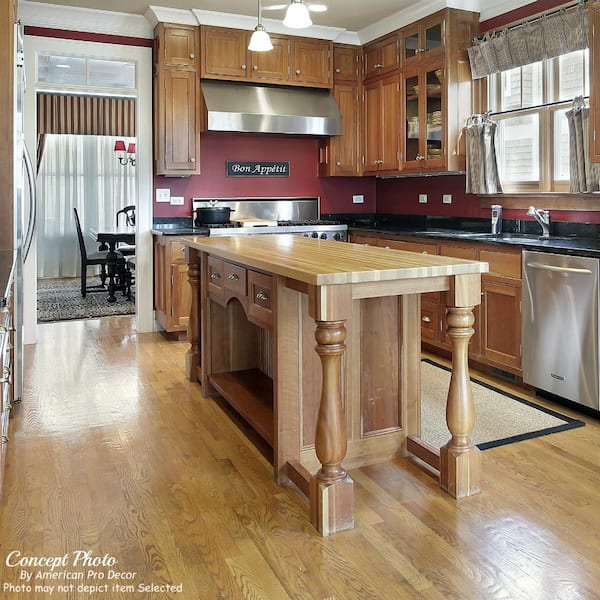An Overview to Choosing the Perfect Legs For Kitchen Island for Your Home
Selecting the optimal legs for your kitchen area island is a nuanced decision that influences both the performance and aesthetic charm of this central area. As you think about these aspects, it comes to be apparent that the right legs can change not only the look of your kitchen area yet likewise its functionality for years to come.

Recognizing Kitchen Area Island Legs
When choosing legs for a kitchen island, it's vital to understand their aesthetic and useful roles in the overall design. The legs offer as a crucial support group, making sure stability and toughness for the island, which often works as a work area, dining area, or collecting area. The selection of material and building technique need to be durable enough to hold up against everyday usage and potential wear.
In addition to their architectural responsibilities, legs add substantially to the island's aesthetic allure. They can boost the kitchen's design, whether with conventional, contemporary, or eclectic layouts. The height and proportion of the legs are additionally crucial factors to consider; they need to integrate with the island's countertop height while making certain comfortable seating for those making use of the space.
Moreover, the leg layout can influence the general circulation of the cooking area. Open, ventilated leg designs can produce a sense of lightness, while solid, substantial legs may share a much more based and stable aesthetic - Legs For Kitchen Island. Comprehending these visual and functional aspects will certainly guide home owners in making notified options that complement their kitchen area's design and improve its usability
Popular Styles and Materials
The selection of legs for a kitchen area island includes a variety of popular styles and products, each offering unique features that can enhance both capability and aesthetics. Amongst one of the most sought-after styles are contemporary, rustic, and conventional. Contemporary legs often include smooth, minimal layouts that stress simplicity and tidy lines, making them perfect for modern-day kitchen areas. Rustic styles, on the other hand, embrace natural environments and commonly showcase reclaimed timber or distressed surfaces, adding heat and beauty to the area. Standard legs normally display elaborate details and workmanship, enhancing timeless kitchen area designs.

Elevation and Stability Considerations

The legs of the kitchen island ought to provide sufficient support, guaranteeing that the framework can stand up to day-to-day usage without shifting or tottering. Material choice plays a considerable role in security; metal legs, for circumstances, have a tendency navigate to this site to use higher stamina contrasted to wood.
Matching Your Kitchen Visual
Choosing the ideal legs for your kitchen island goes past performance; it additionally plays a significant function in the total visual of the room (Legs For Kitchen Island). When choosing legs, take into consideration the design style of your cooking area.
Color is an additional crucial variable. Legs that match or comparison with your island's surface area and surrounding kitchen cabinetry can create visual consistency or striking centerpieces. Pairing dark timber legs with a light marble kitchen counter can add deepness and passion. In addition, consider the coating of the legs; matte, glossy, or distinctive surfaces can considerably influence the total feel of the cooking area.
Installation and Maintenance Tips
Setting up cooking area island find more information legs calls for mindful focus to information to make sure both security and aesthetic appeal. Begin by choosing an ideal place for your island, guaranteeing it is degree and has adequate room for activity. If you are connecting the legs to a wall or using braces for added support, use a stud finder to locate wall surface studs. Mark the placement of the legs properly prior to drilling.
When protecting the legs, make use of go to this web-site premium screws and, if essential, wood glue for extra toughness. For metal legs, guarantee that you are making use of appropriate anchors and devices to stop damage to your flooring. It is a good idea to examine for levelness after installation, making adjustments as needed to stay clear of tottering.
Tidy the legs with an appropriate cleaner, preventing rough materials that may scratch the surface. By adhering to these installment and maintenance tips, you can ensure that your cooking area island legs continue to be both useful and aesthetically appealing.
Final Thought
Finally, selecting the appropriate legs for a cooking area island demands cautious consideration of elevation, security, and aesthetic compatibility. By choosing ideal materials and styles that straighten with the general kitchen layout, capability can be improved while maintaining aesthetic charm. Correct setup and recurring maintenance better add to the sturdiness and long life of the kitchen area island. Ultimately, thoughtful leg option plays an essential duty in raising both the usefulness and style of the kitchen room.
When choosing legs for a cooking area island, it's important to recognize their functional and visual functions in the total design. Open, ventilated leg designs can create a sense of agility, while strong, considerable legs might share a more based and secure aesthetic. The legs of the kitchen island must provide appropriate assistance, guaranteeing that the framework can hold up against daily use without shifting or wobbling.Setting up kitchen area island legs needs mindful focus to detail to guarantee both security and visual allure.In verdict, selecting the appropriate legs for a kitchen island necessitates careful factor to consider of elevation, security, and aesthetic compatibility.